Japanese Beetles: How to Get Rid, Control, and Kill Japanese Beetles (With Pictures)
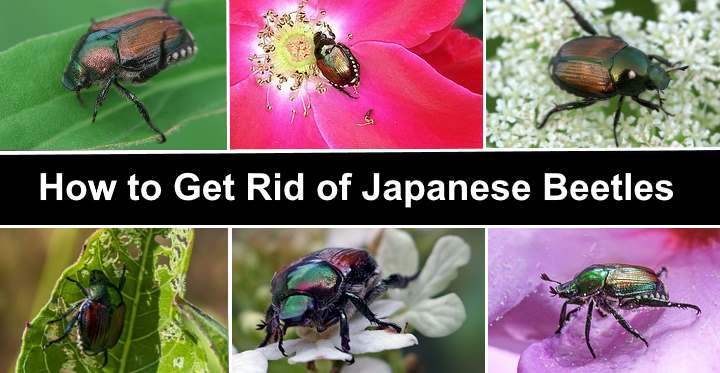
Japanese beetles (Popillia japonica) are small, destructive pests that feed on plant foliage, destroying the leaves of many ornamental plants, trees, and shrubs. Japanese beetles look like shiny insects with green and gold iridescent coloring. The colorful, gleaming beetles start their life as white grubs living in the ground before emerging to wreak havoc on garden plants. There are several ways to naturally eliminate the six-legged pests, including using neem oil sprays for Japanese beetles.
Getting rid of Japanese beetles requires a multi-method approach. As well as using sprays to kill beetles, you can grow plants that repel these colorful beetles. At the same time, it’s vital to avoid planting shrubs that attract the leaf-eating pests. Then, prevention methods such as beneficial insects, using row covers, or diatomaceous earth can help rid your garden of Japanese beetles.
This article is a complete guide on the best natural control methods for Japanese beetles. You will also learn about the life cycles of these shiny green and gold insects to minimize Japanese beetle damage in your garden.
What Is a Japanese Beetle Grub?
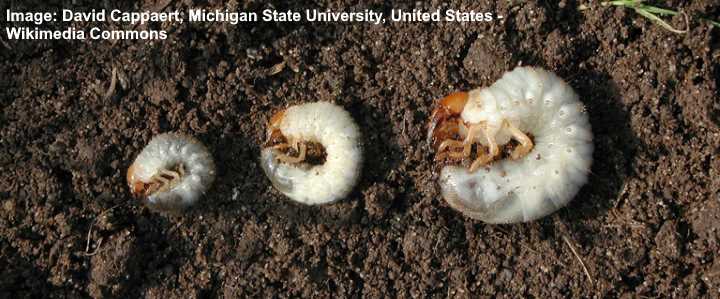
Japanese beetle grubs
A Japanese beetle grub is the larval stage of the pesky shiny beetles. The fat, white worm-like grubs live in the ground and gorge on grass roots or the roots of ornamental shrubs. As the grubs grow larger, they become a characteristic C-shape. Japanese beetle grubs spend their life underground before pupating.
Because of their underground existence, you may only see the damage the grubs cause. Lawn damage is a typical sign of Japanese beetle grubs. As the larvae feed on the roots of turfgrass, brown or bare patches develop on lawns. Usually, the best way of getting rid of lawn grubs is to prevent the beetles from laying eggs.
What Do Japanese Beetles Look Like?
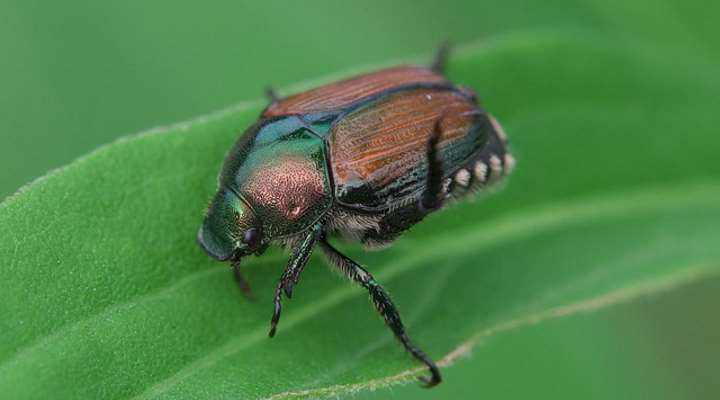
Japanese beetles have iridescent green and copper colors and white tufts on each side
Japanese beetles (Popillia japonica) are shiny oval insects with a brightly-colored metallic bodies. The head and thorax are an iridescent green, and they have a golden-copper glossy back. The beetles measure 0.6” (1.5 cm) long and 0.4” (1 cm) wide. Distinguishable five white tufts along the beetle’s abdominal section help identify the beetle.
Japanese Beetle Life Cycle
Japanese beetle life cycle starts as an egg that hatches into a white grub, then pupates and emerges as a shiny adult beetle. The beetle’s life cycle takes one year. Females lay eggs in spring when they emerge from the ground. A female can lay up to 60 eggs in her lifetime.
Japanese beetle eggs hatch in ten to 14 days. During the next ten months, the grubs spend life in the ground feeding on roots. After that, the grubs go through three instars (stages) and then hibernate during the winter. They then emerge in spring, where the beetle life cycle starts over again.
Adult Japanese beetles spend nights on the shrubs and trees where they feed. Usually, the colorful beetles are most active during warm summer days. But the best time to handpick the destructive beetles from shrubs, bushes, and trees is in cool mornings when they are less active and easier to kill.
How to Identify Japanese Beetle
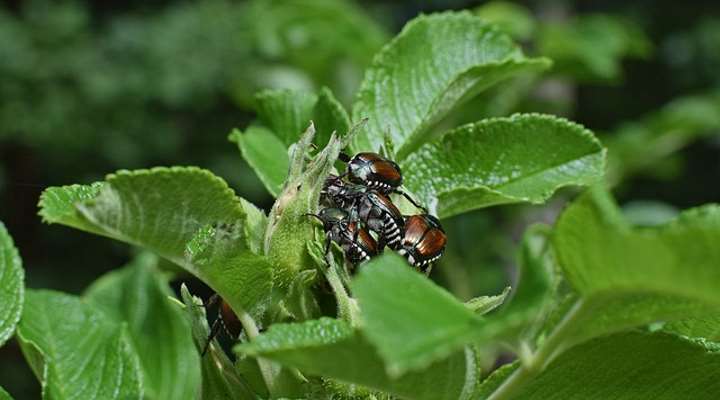
A group of Japanese beetles
To identify Japanese beetles, look for six-legged shiny beetles and plant damage. Japanese beetles are identified by their metallic green heads, shimmering coppery back, and five white tufts along their side. The beetles skeletonize foliage. You can identify Japanese beetle damage by the leaf’s lacy appearance caused by numerous holes.
What Do Japanese Beetles Eat?
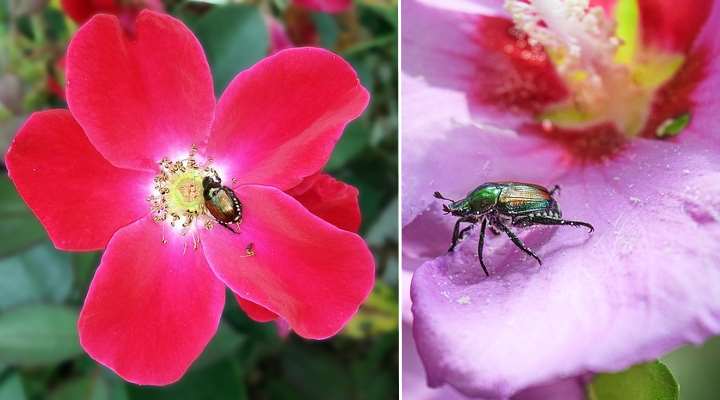
Japanese beetles eat flowers such as roses and hibiscus
The type of plants that Japanese beetles prefer to eat include roses, birch leaves, beech foliage, apple tree leaves, poplars, azaleas, hibiscus, legumes, and maple tree leaves. Unfortunately, Japanese beetles feed on a wide range of plants, defoliating foliage, and leaving behind a trail of destruction.
If Japanese beetles cause problems in your area, you can grow plants that the colorful beetles tend to avoid. Plants that Japanese beetles stay away from include lilac, dogwood, boxwood, spruce, hemlock, and yew. At the end of the article, you will find a list of plants that help to repel Japanese beetles.
Signs of Japanese Beetle Damage
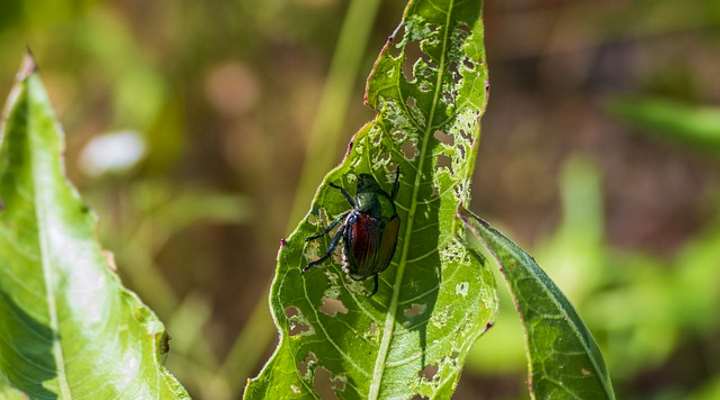
Japanese beetle damage to leaves
Skeletonized leaves are the most common sight of Japanese beetle plant damage. The shiny green and gold beetles only eat the parts of the leaves between leaf veins. The damaged leaves caused by beetles resemble a piece of lace. When recognizing Japanese beetle damage, you should inspect all plants nearby.
Japanese beetles tend not to travel far from the plants they feed on. So, looking for plant damage such as skeletonized leaves is the first step in removing the plant-hungry beetles from other plants.
Signs of Japanese Beetle Grub Damage
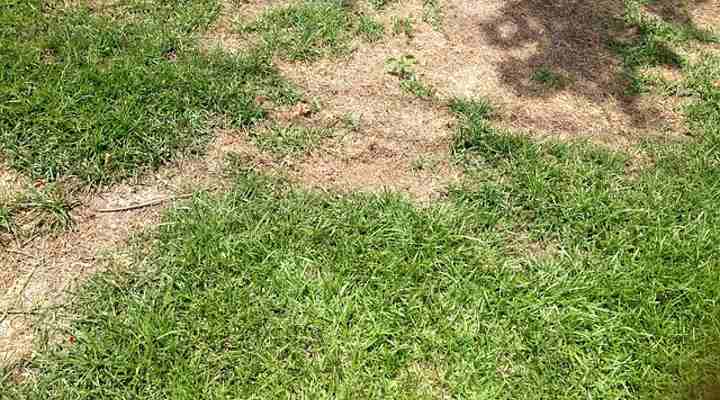
Grub damage to lawn
Signs of damage caused by Japanese beetle grubs are more challenging to identify. The fat, white c-shaped worms live underground munching on roots. Typically, grub damage looks like patches of dead grass or young plants with stunted or withered foliage. The challenge in recognizing Japanese beetle grub damage is that the signs could indicate other issues such as pests, poor soil, or drought.
Further reading: How to Get Rid of Grubs in the Garden.
Where do Japanese Beetles Come From?
Japanese beetles come from the ground in June and July after the plump white grubs pupate. But Japanese beetles can also come from nearby gardens. When the plant-destroying insects start feeding, they release pheromones that attract other beetles. So, unless you act fast to eliminate Japanese beetles, you could have an uncontrollable problem with beetles in your garden.
As the common name suggests, Popillia japonica is a beetle species that originated in Japan. However, it is thought that they arrived in the US in the 1900s when trade with Japan started. Because the iridescent beetles are not native insects, they quickly became a significant pest in gardens and crop-producing fields.
How to Get Rid of Japanese Beetles
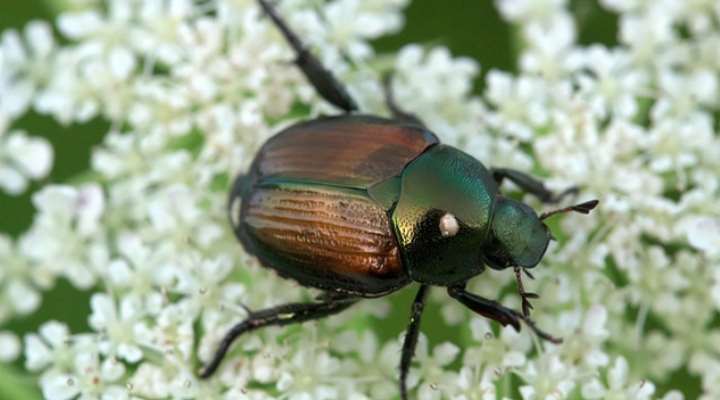
Getting rid of Japanese beetles requires a multi-method approach
Getting rid of Japanese beetles for good requires a concerted effort to destroy the grubs, killing adult beetles, and preventing further infestations in your yard. Please read on to learn about natural methods for controlling, killing, and preventing Japanese beetles.
Hand Pick Japanese Beetles to Get Rid of Them
The first step to getting rid of Japanese beetles is to remove the shimmering insects physically. In mid-summer, you should start inspecting plant foliage for signs of beetle damage. The best time to check is on cool mornings when the shiny insects tend to be less active.
The easiest way to handpick and destroy the beetles is to shake the host plant. Then, gather up all iridescent green beetles you find and drop them in a bucket of soapy water.
You should also inspect the types of ornamental shrubs that Japanese beetles love to eat. For example, look in rose flowers and under rose bush leaves for shiny green beetles. Removing gleaming beetles from fruit trees, rhododendron bushes, pea plants, and fruit bushes will also help prevent the beetles from attracting more insects.
Japanese Beetle Traps
Traps are used to lure beetles to yards with the idea that they get trapped and then cause less damage to plants. The beetle traps use sweet-smelling odors that attract the flying insects. Some traps claim to get rid of dozens of beetles daily. Unfortunately, studies show that traps are rarely effective in getting rid of Japanese beetles.
Although traps are claimed to work by capturing numerous Japanese beetles, they tend to attract more beetles than they catch. So, experts warn that beetle traps can cause more harm than good. Moreover, even the placement of traps doesn’t do much to increase their effectiveness.
How to Kill Japanese Beetles
Natural Japanese beetle sprays using neem oil or insecticidal soap can effectively eradicate beetles from plants and prevent further damage. You can also use non-toxic powders such as diatomaceous earth as a natural beetle killer.
Neem Oil Spray to Kill Japanese Beetles Naturally
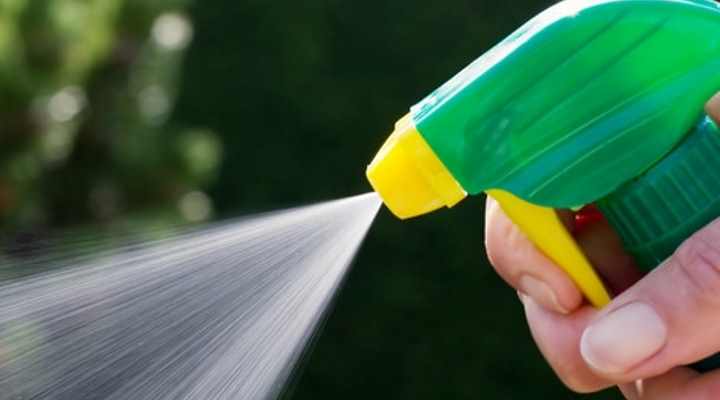
Neem oil spray helps to eradicate Japanese beetles
Make a natural neem oil spray to exterminate Japanese beetles on your prized ornamental shrubs and flowers. To make the beetle spray, mix 2 tsp. neem oil and 1 tsp. Castile soap with 1 quart (1 l) of water in a spray bottle. Thoroughly shake the bottle, then spray on plants.
For best results, use neem oil for spraying plants affected by Japanese beetles. First, thoroughly cover the leaves and flowers with the spray solution. Spraying the plants in the evening once a week and continuing while the Japanese beetles are active is crucial for getting rid of them.
Neem oil contains a natural pesticide called azadirachtin that can kill Japanese beetles and damage their lifecycle.
Scientific studies back up the use of neem oil as an effective natural treatment for Japanese beetles. For example, regarding the effect of neem oil on insects, scientists report that neem oil “repels, retards growth, inhibits feeding, disrupts growth” of Japanese beetles.
Neem oil to kill Japanese beetle grubs
Neem oil can also be an effective natural treatment to prevent and kill Japanese beetle grubs living in the ground or lawns. Use two tablespoons of neem oil for every gallon (3.7 l) of water. Use a hose spray applicator or watering can to water your lawn. Apply every seven days during late summer to kill off immature larvae in the ground.
There is scientific evidence that neem oil is an effective Japanese beetle grub killer. One study found that applying neem oil to lawns helps kill Japanese beetle grubs in their second instar. This is enough to stop the beetles from hatching and causing damage to your plants.
Use Insecticidal Soap Spray to Kill Japanese Beetles
You can make a spray to eliminate Japanese beetles by spraying insecticidal soap on plants. To make a DIY spray for beetle control, use an all-natural soap such as Castile soap. This contains oils and fatty acids that break down the outer layer of beetles to kill them without harmful chemicals.
To make your own Japanese beetle insecticidal soap spray, mix five tablespoons of liquid Castile soap with a gallon (3.7 l) of water. Next, add two tablespoons of vegetable oil to help thicken the solution. Mix thoroughly to emulsify the spray liquid. Then, use a pressurized garden spray to apply the natural insecticide to kill Japanese beetles.
Use the beetle spray every four to seven days until you no longer see Japanese beetles on plants or signs of new plant leaf damage.
Diatomaceous Earth (DE) Kills Japanese Beetles
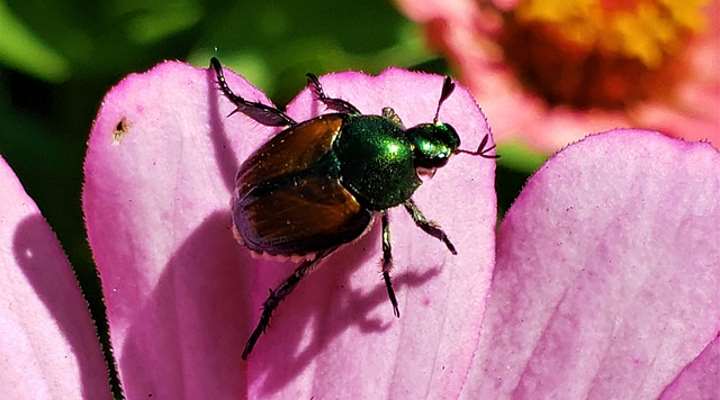
DE powder is effective in eliminating Japanese beetles only if it’s dry
Sprinkling diatomaceous earth (DE) on plant foliage, stems, and on the ground can help kill Japanese beetles. Diatomaceous earth is a natural substance that destroys the exoskeletons of beetles. You only have to sprinkle the white powder on dry ground or foliage for it to be effective.
The best time to apply DE to kill beetles is in June, when they emerge from the ground. Also, you must reapply the powder after rainfall or watering the garden because diatomaceous earth is ineffective when it’s damp.
How to Control Japanese Beetles
Controlling Japanese beetles is also an essential part of pest control to stop the beetles from eating your roses, legumes, ornamental bushes, or fruit trees.
Use Row Covers to Prevent Japanese Beetles Damaging Plants
Row covers physically keep Japanese beetles away from your plants and prevent beetle damage. The best time to install beetle-protective covers is in late spring or early summer, before the beetles emerge from the ground. However, it’s good to remember that row covers will also prevent pollinators from pollinating your crops.
Plants That Deter Japanese Beetles
Certain strong-smelling plants can help keep Japanese beetles away from your garden. The plant foliage either tastes terrible to the gorging beetles or emits a potent odor that repels Japanese beetles. Thus, beetle-repelling plants are another tool to use in the battle to eradicate Japanese beetles from garden landscapes.
The list of plants that deter Japanese beetles includes onions, garlic, catnip, marigolds, larkspur, leeks, and white geranium. You can grow these plants near your prized ornamental shrubs. They may repel the beetles from attacking your beautiful flowering bushes and shrubs.
There are also flowering plants and evergreen perennials that are resistant to Japanese beetles. Some examples of plants that don’t attract beetles are lilac, begonias, magnolia, most types of conifers, hydrangea, and boxwood shrubs.
At the same time, it’s vital to avoid plants in your garden such as roses, fruit trees, hibiscus, legumes, and rhododendrons if you are battling with a Japanese beetle invasion.
Essential Oil Spray as a Natural Japanese Beetle Repellent
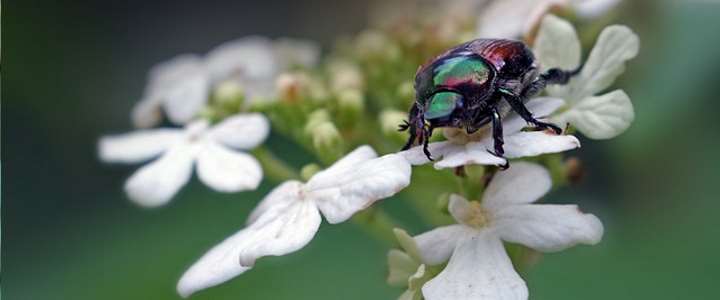
You can prepare essential oils spray to repel Japanese beetles
Use essential oil sprays to repel Japanese beetles. Mix 15 drops of wintergreen essential oil or peppermint oil for every cup of water. Mix well and spray liberally on plants to prevent Japanese beetles from inflicting damage on plant leaves and flowers. Apply every other day for best results to keep beetles away from your plants.
Scientific studies back the use of essential oils as a Japanese beetle repellent. For example, a 2009 study found that a combination of wintergreen oil with peppermint oil was highly effective at repelling Japanese beetles. Other effective essential oils to repel Japanese beetles are citronella oil and ginger oil.
How to Prevent Japanese Beetles
Getting rid of Japanese beetles for good also requires preventative controls to stop eggs hatching or prevent beetles from laying eggs.
Use Milky Spore Powder to Help Prevent Japanese Beetles
Milky spore powder (Bacillus popilliae) can help prevent Japanese beetle grubs from hatching and developing in the ground. This non-toxic solution for Japanese beetles causes a bacterial infection in grubs that stop them from hatching. All you need to do is apply the milky spore powder to lawns and then deeply water the turfgrass to eliminate grubs.
Beneficial Nematodes to Kill Japanese Beetle Grubs
Nematodes are parasitic worms that live in the soil and kill beetle grubs. Like milky spore powder, the beneficial worms cause a bacterial infection in the plump white grubs. This ends up killing the beetle grubs, meaning fewer of them, if any, hatch in mid-summer.
Biological Control to Eliminate Japanese Beetles
Introducing parasitic wasps to your garden can help prevent Japanese beetles. Two species of tiphiid wasps, Tiphia popilliavora and Tiphia vernalis, attack young grubs in late summer or overwintering grubs in the fall or winter. Additionally, a type of tachinid fly, Istocheta aldrichi, attacks and kills adult Japanese beetles.
Related articles:
- Types of Beetles – Identification Guide
- Black Beetles Identification
- Neem Oil for Plants: Usage Guide
